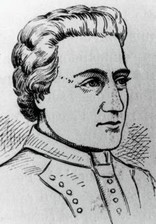Daniel d'Auger de Subercase facts for kids
Quick facts for kids
Daniel d'Auger de Subercase
|
|
|---|---|

Sketch of Subercase, date unknown
|
|
| Born | 12 February 1661 Orthez, Béarn, France |
| Died | 20 November 1732 (aged 71) Cannes, France |
| Allegiance | |
| Years of service | 1674-1713 |
| Rank | Governor of Placentia and Acadia |
| Awards | Order of Saint Louis |
Daniel d'Auger de Subercase (born February 12, 1661 – died November 20, 1732) was a French naval officer. He became an important governor for France in North America. He governed Newfoundland and later Acadia.
Subercase was born into a wealthy merchant family in France. He was a Protestant and his family owned noble lands.
Contents
A French Governor in North America
Daniel Subercase started his military journey in the French army. He served for about 10 years. By 1684, he was a captain in the Régiment de Bretagne. Later, he joined the French navy.
Arriving in Quebec
In 1687, Subercase sailed to Quebec in North America. Soon after arriving, he joined a military campaign. He fought alongside his soldiers against the Senecas. By 1693, he had risen in rank. He became a lieutenant-commander and an adjutant general.
Governor of Plaisance
In 1702, Daniel Subercase became the governor of Plaisance. This was a French settlement in Newfoundland. He arrived there in 1703, during the early years of Queen Anne's War. This was a big war between France and England.
Defending Plaisance
Soon after arriving, Subercase learned of a planned English attack. A large English fleet was heading for Plaisance. He quickly prepared the town's defenses. With the help of two French warships, he managed to stop the attack. The English fleet decided not to attack Plaisance.
Attacks on English Settlements
In late 1704, Subercase planned attacks against English outposts in Newfoundland. He gathered 100 extra soldiers from Canada. With 350 of his own men, he launched a major campaign.
In January 1705, his forces captured Bay Bulls and Petty Harbour. They then tried to capture the main English settlement at St. John's. This was known as the Siege of St. John's. However, they could not take the fort.
Despite this, Subercase's expedition caused a lot of damage. They destroyed many English colonies. Only Carbonear Island remained untouched. They took 1,200 prisoners. They also destroyed many cannons and fishing boats. Subercase believed his actions caused great losses for the English.
Governor of Acadia
After his time in Newfoundland, Subercase worked to improve Plaisance. He rebuilt its defenses and boosted the spirits of the people. In 1705, he received an award, becoming a knight of the Order of Saint-Louis.
In April 1706, he became the governor of Acadia. This was another important French territory.
Defending Port Royal
Subercase faced new challenges in Acadia. In 1707, the English tried to capture Port Royal twice. Subercase successfully defended the fort both times. His forces were outnumbered, but he led several brave attacks himself. In one fight, his own horse was killed beneath him.
However, the governor of Boston was determined to win. In October 1710, a large English fleet arrived at Port Royal. General Francis Nicholson led this fleet. It had 2,000 soldiers and 36 ships. Subercase had fewer than 300 men to defend the fort.
After a few days of fighting, Subercase had to surrender. Port Royal was damaged and running out of supplies. He handed over Port-Royal to the British. This event was known as the Siege of Port Royal.
Later Life
Some officers blamed Subercase for the loss of Port Royal. He was called before a military court in France. However, he was quickly found innocent.
In 1711, he was offered a new role in Quebec. He was asked to plan how to retake Port Royal. But Subercase refused, feeling upset. Two years later, the Treaty of Utrecht was signed. This treaty ended the fighting between France and England. It also gave Acadia and Newfoundland to England for good. This made Daniel Subercase the last French governor of Acadia.
Subercase then retired and returned to France. He lived on his family's lands. He continued to receive a captain's pension until he passed away on November 20, 1732, in Cannes, France. His grave is marked in the church of that village.
See also
- List of governors of Acadia
- Governors of Newfoundland
- List of people of Newfoundland and Labrador

